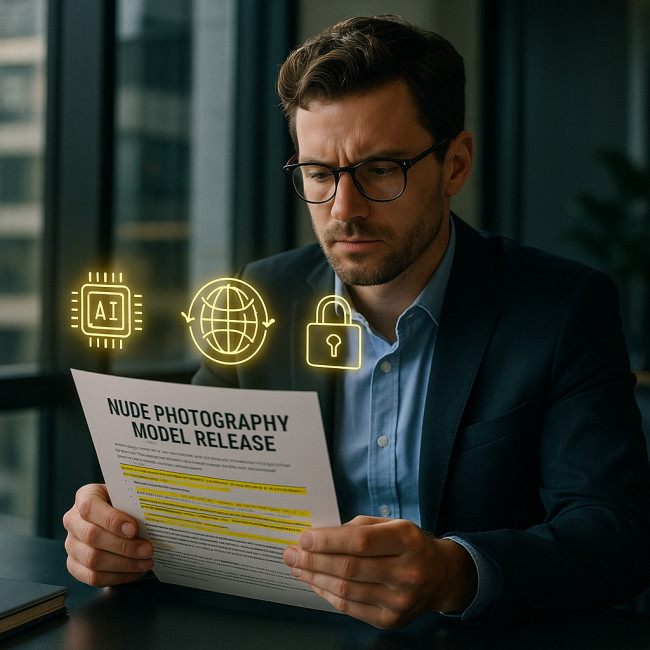Model releases for nude imagery: privacy clauses recruiters look for today
A watertight model release is the passport that lets recruiters share, license and monetise nude photographs without jeopardising a model's dignity or a brand's reputation. Discover which privacy clauses are now non-negotiable, how to draft them in plain English and the red flags that make casting teams walk away.
Why privacy clauses have become a deal-breaker

High-resolution cameras, frictionless reposting and AI image generators mean a single nude frame can circle the globe in minutes. Recruiters therefore scan every release for explicit privacy wording before approving a booking. A missing clause can spark reputational damage or even litigation, so producers favour artists who present releases that already close those gaps.
- Data leaks shoot up: 23% of creative agencies faced an unauthorised image leak in the past two years.
- AI training concerns: Generative models scrape public datasets; a release without an AI-exclusion clause looks outdated.
- Global regulations tighten: The EU Digital Services Act and state-level US laws now back models who claim misuse of sensitive content.
Core privacy concerns recruiters flag first
1. Unrestricted distribution channels
Traditional releases mention “print, web and social media”. Recruiters now add language that limits resale to stock libraries, NFT marketplaces and AI datasets unless the model grants an opt-in. Linking to an ethical nude-shoot guideline within your deck reassures clients that you respect those boundaries.
2. Geographical scope
A global licence sounds convenient, yet it exposes models to legal systems that treat nude content differently. Modern releases often restrict use to regions where content guidelines align with the model's comfort level.
3. End-of-life removal
Brands increasingly agree to a “sunset clause” that lets the model request removal after a set period—typically five years—or when a campaign ends. Recruiters like this because it reduces future takedown disputes.
4. Searchability shields
Requests to hide real names from metadata—especially on large photo directories—are standard. Some photographers offer pseudonym tagging plugins for platforms such as the artistic nude photographers directory so casting teams can still find work without exposing personal details.
Privacy clauses that make your release recruiter-ready
| Clause | Purpose | Recommended Wording Snippet |
|---|---|---|
| Channel Limitation | Prevents resale to AI or stock sites | “The imagery shall not be licensed to machine-learning datasets or third-party stock libraries without written consent from the Model.” |
| Time-Bound Usage | Ensures images disappear after a campaign | “Usage rights expire 5 years after first publication or on 31 Dec 2029, whichever comes first.” |
| Pseudonymity | Hides legal identity from search engines | “Credits will use the professional alias ‘Aria V.' with no links to personal social profiles.” |
| Geo-Blocking | Protects against markets with lax privacy laws | “Distributor agrees to block IP addresses originating from jurisdictions listed in Annex A.” |
| Revocation Right | Allows future takedowns for safety reasons | “Model may request removal of imagery from digital platforms within 30 days of written notice.” |
How to negotiate enhanced privacy without losing the booking
- Share a draft early. Email the PDF before the call sheet. Recruiters appreciate time to loop in legal teams and rarely reject well-reasoned clauses.
- Offer tiered fees. Higher privacy equals higher editing and archive costs. Provide two price points—standard usage and privacy-enhanced—so clients feel in control.
- Reference industry standards. Point to APA or PACT guidelines plus resources like lighting setups for inclusive skin tones to show you follow best practices.
- Stay solution-oriented. If a brand balks at geo-blocking, propose watermarking or lower-resolution web files as compromise.
Template add-ons that speed up approval
Smart QR-code signature block
A scannable code links to a cloud folder containing IDs, W-9 and backstage stills. Recruiters tick compliance boxes in minutes.
AI-exclusion statement
Add a single line: “Images captured under this release are excluded from training or synthesising artificial content.” Legal teams now ask for this by default.
Metadata checklist
- Strip GPS coordinates
- Add alias to IPTC “Creator” field
- Embed expiry date in “Rights Usage Terms”
Automating the above with Lightroom presets reduces human error.
Common mistakes that trigger red flags
Recruiters disclose that 37% of incoming releases lack at least one mandatory privacy element. Avoid these pitfalls:
- Copy-pasted templates from fashion shoots. Nude work demands stricter distribution limits.
- Ambiguous usage window. “In perpetuity” is no longer acceptable without a significant premium.
- Missing jurisdiction clause. Silence on governing law complicates cross-border disputes.
- No witness signature. A self-signed release is weak evidence in court.
Recruiter's 60-second checklist
Before green-lighting a talent profile, casting managers confirm these points:
- Model's legal name and alias both present
- Time-bound usage clearly stated
- Explicit AI/stock exclusion
- Revocation process outlined
- Witness or notary signature included
Models who publish the above on their directory pages, similar to the privacy-versus-reach guide, surface faster in shortlist filters.
Case study: securing a gallery deal with a privacy-forward release

Fine-art photographer “Lena K.” booked a solo show after a curator discovered her series through an artistic nude curation strategy. The gallery's legal counsel approved the booking within 24 hours because her template already separated exhibition rights from online promotion, included geo-blocking for regions with strict morality laws and capped usage to three years. The curator called it “the most model-centric release we've reviewed this season”.
FAQ
- Do I still need a privacy clause if the shoot is TFP?
- Yes. Even unpaid collaborations can spiral into commercial use if an image goes viral. Recruiters avoid TFP content without clear privacy language.
- Can I charge extra for extensive geo-blocking?
- Absolutely. Geo-blocking requires additional CDN settings and monitoring. State the fee transparently in your rate card.
- Is an AI-exclusion clause legally enforceable?
- While precedents are emerging, having the clause signals intent and allows you to claim damages if the client violates the agreement.
- What happens if a brand refuses a revocation right?
- Negotiate shorter licence duration instead. A two-year cap often satisfies both parties.
- Should witnesses sign digital releases?
- Yes. Use platforms that support multi-party e-signatures with time stamps to strengthen admissibility in court.
Quick quiz: test your release IQ
Take-away
In 2024, privacy isn't an add-on—it's the foundation of every model release involving nude content. Draft clauses that anticipate AI, geo-blocking and takedown rights, and you will fast-track approvals while commanding higher fees. Need a ready-to-sign template? Download our checklist and approach your next shoot with confidence.
Ready to upgrade your release? Review your current document today and share it with your favourite casting manager. A two-hour legal polish could unlock premium campaigns tomorrow.











